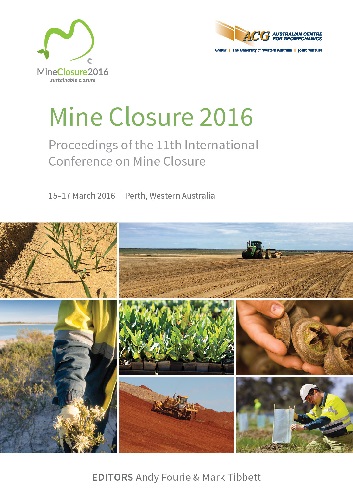Waste material placement options during construction and closure risk reduction — quantifying the how, the why and the how much

|
Authors: Pearce, S; Lehane, S; Pearce, J |
DOI https://doi.org/10.36487/ACG_rep/1608_51_Pearce
Cite As:
Pearce, S, Lehane, S & Pearce, J 2016, 'Waste material placement options during construction and closure risk reduction — quantifying the how, the why and the how much', in AB Fourie & M Tibbett (eds), Mine Closure 2016: Proceedings of the 11th International Conference on Mine Closure, Australian Centre for Geomechanics, Perth, pp. 691-706, https://doi.org/10.36487/ACG_rep/1608_51_Pearce
Abstract:
Technical aspects of waste rock characterisation and assessment have been the focus of considerable research over the past decade, with many guidance documents being published on the subject internationally and within Australia. While these documents provide detailed information on how to characterise waste rock, there is not a great amount of guidance on how the placement of waste rock can be optimised to account for the results of the characterisation studies. In this respect it could be reasonably concluded that the science has progressed to a more advanced stage for waste classification in comparison to how to manage it. This has lead in many cases to site specific waste characterisations being followed up with generic waste management solutions such as widespread adoption of the ubiquitous potential acid forming cell as a management solution. The net result of this mismatch is that although acid and metalliferous drainage (AMD) assessments are undoubtedly being carried out to a higher level of detail than in the past, there is not a definitive correlation with site management practices and, therefore, effective closure risk reduction over this time. The net effect of this trend has been that site operators are being given better information on AMD risks, but not better solutions on how to manage these risks. That is to say site operators are being told why they should manage risks but not how to achieve this, and by how much risks can effectively be managed (if at all). Questions that site engineers and operators may ask about the relative benefit of one placement solution over another have for the most not been adequately addressed by research. Examples include assessment of the quantitative benefit of paddock dumping vs end tipping, determining the optimal tip head height for waste placement in a storage facility, and how sulphide grade control should be carried out. A detailed risk-based investigation of the influence of factors common to waste placement is presented herein and has been completed as part of a wider research initiative to investigate the technical aspects of developing a quantitative assessment tool. Applying a numerical modelling approach to assessment of the different waste material placement strategies allows for the graphical presentation and communication of the variation in risk through risk matrices and histograms.
Keywords: waste placement
References:
Brown, PL, Logsdon, MJ, Vinton, B, Schofield, I & Payne, K 2014, ‘Detailed characterisation of the waste rock dumps at the Kennecott Utah Copper Bingham Canyon Mine – Optionality for Closure’, in H Miller & L Preuss (eds) Proceedings of the Eighth Australian Workshop on Acid and Metalliferous Drainage, Adelaide, pp 1–12.
Lottermoser, BG 2010, Mine wastes characterization, treatment and environmental impacts, third edition, Springer, Berlin.
Morin, KA, Gerencher, E, Jones, CE & Konasewich, DE 1991, ‘Critical Literature Review of Acid Drainage from Waste Rock’, MEND Report 1.11.1.
Nichols, RS 1986, ‘Rock segregation in waste dumps’, in Proceedings of the International Symposium on Flow-Through Rock Drains, Cranbrook, B.C., Canada.
Pearce, SR 2014, ‘Beyond the PAF Cell’, in H Miller & L Preuss (eds), Proceedings of the Eighth Australian Workshop on Acid and Metalliferous Drainage, JK Tech, Indooroopilly, Australia, pp. 97–110.
Pearce, S & Barteaux, M 2014a, ‘Instrumentation in waste rock dumps: Going deeper’, in H Miller & L Preuss (eds) Proceedings of the Eighth Australian Workshop on Acid and Metalliferous Drainage, Adelaide, pp 371–386.
Pearce, S & Barteaux, M 2014b, ‘Instrumentation of waste rock dumps as part of integrated closure monitoring and assessment’, in Proceedings of 9th International Conference on Mine Closure, Johannesburg.
Pearce, SR & Lehane, S 2015, ‘Quantitative risk assessment tools to assist with waste management and placement guidelines’ in AB Fourie, M Tibbett, L Sawatsky & D van Zyl (eds), Mine Closure 2015 Proceedings of the 10th International Conference on Mine Closure, Vancouver.
Wilson, W 2011, ‘Rock Dump Hydrology: An overview of full-scale excavations and scale-up experiments conducted during the last two decades’, in LC Bell & B Braddock (eds), Proceedings of the Seventh Australian Workshop on Acid and Metalliferous Drainage, pp 307–322.
© Copyright 2026, Australian Centre for Geomechanics (ACG), The University of Western Australia. All rights reserved.
View copyright/legal information
Please direct any queries or error reports to repository-acg@uwa.edu.au
View copyright/legal information
Please direct any queries or error reports to repository-acg@uwa.edu.au